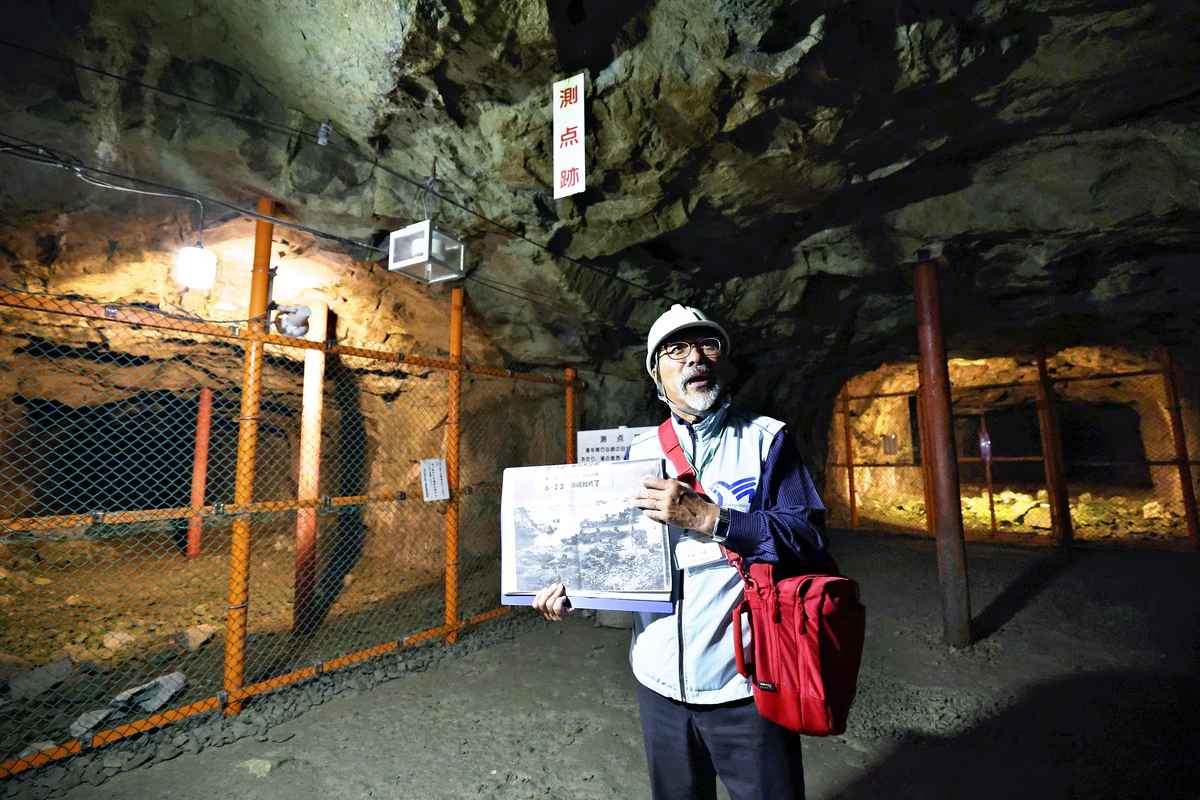
The Yomiuri Shimbun
Michimasa Matsuki of the nonprofit organization Matsushiro Peace Museum guides visitors in a bunker under Mt. Zozan in Nagano City.
6:00 JST, October 12, 2025
An archive museum telling the history of a planned underground Imperial headquarters began operating this weekend in Nagano City.
In the last phase of the Pacific War, the Imperial Japanese military secretly intended to make huge excavations in Nagano Prefecture, as they planned to move the Emperor’s residence and central government ministries there.
Construction of the headquarters, called Matsushiro Daihonei, began in November 1944 with the drilling of a total of about 10 kilometers of bunkers in Mt. Zo, Mt. Maizuru and Mt. Minakami in the Matsushiro district in Nagano. About 10,000 Japanese and Korean laborers are said to have worked on the construction.
The headquarters, however, was never used, as Japan lost the war.
Currently, only the structure under Mt. Zo is open to the public, with about 46,000 people visiting the site in fiscal 2024.
Difficult construction work
Stepping into the entrance of the bunker at the foot of the mountain, you can see rugged rock walls and uneven ground extending deep inside. The 4-meter-wide, 2.7-meter-high underground space at the entrance was enveloped in cold air, and bats flew around.
Twenty major bunkers were dug in parallel, each measuring 150-300 meters long. Several tunnels connect to the major bunkers, giving the whole structure a grid-like pattern.
The tip of a digging drill is left piercing a rock wall, revealing how hard the rock is. You can also see old wooden railroad ties for a mining tram that carried out pieces of rock after they were blown up with dynamite.
Nagano was chosen for the site because it is far from seashores, which U.S. forces could use as landing areas, as well as its solid bedrock, which was thought to be suitable for underground bunkers. To maintain secrecy, the military told local residents that warehouses were being built.
There was also a plan to bring the Imperial Family’s Three Sacred Treasures, which symbolize the throne.
The construction was carried out at a fast pace for the sake of maintaining Japan’s Imperial system.
Local nonprofit organization Matsushiro Peace Museum has been studying the history of the underground headquarters and provides guided tours of the bunker.
“The bedrock was really hard, so the work was extremely difficult, and there were many casualties, including people who were caught up in dynamite explosions,” said Michimasa Matsuki, 71, a member of the NPO.
After the war, some parts of the structure were turned into a facility for observing earthquakes under what is now the Japan Meteorological Agency. Most other parts, however, were abandoned and their stories were left untold.
In the 1980s, local high school students and volunteers began researching the ruins of the headquarters as part of their hometowns’ wartime history, which led to a reassessment of its value. In 1990, the municipal government opened a 500-meter-long underground bunker to the public.
Diorama on display
The NPO opened the Matsushiro Peace Museum near the entrance to convey the history in greater depth.
The museum, a two-story facility, has on display a diorama showing the entire structure of the former military headquarters, tips of drilling machines used by the laborers and other exhibits. The project cost about ¥45 million, which was financed by crowdfunding and other donations.
The facility also has a pair of notebooks donated by the great-grandchild of a man who lived near the bunker in those years. They contain an illustration of the entrance to one of the bunkers that is currently closed, as well as the names of residents who were forced to relocate their family graves due to soil that was discharged during the drilling work.
According to Takako Kitahara, 83, a member of the NPO, many residents familiar with the digging work used to oppose the museum, saying that they did not want to remember the war anymore.
“Now that 80 years have passed, we can face it in a cool-headed way,” Kitahara said. “We want to make the museum a base for conveying the value of peace.”
The museum will be open to the public free of charge on Sunday and start normal operation on Monday, charging admission of ¥500 for adults.


AloJapan.com